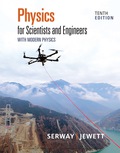
Concept explainers
Your thumb squeaks on a plate you have just washed. Your sneakers squeak on the gym floor. Car tires squeal when you start or stop abruptly. You can make a goblet sing by wiping your moistened finger around its rim. When chalk squeaks on a blackboard, you can see that it makes a row of regularly spaced dashes. As these examples suggest, vibration commonly results when friction acts on a moving elastic object. The oscillation is not
A block of mass m is attached to a fixed support by a horizontal spring with force constant k and negligible mass (Fig. P15.42). Hooke’s law describes the spring both in extension and in compression. The block sits on a long horizontal board, with which it has coefficient of static friction μk and a smaller coefficient of kinetic friction μk. The board moves to the right at constant speed v. Assume the block spends most of its time sticking to the board and moving to the right with it, so the speed v is small in comparison to the average speed the block has as it slips back toward the left. (a) Show that the maximum extension of the spring from its unstressed position is very nearly given by μs mg/k. (b) Show that the block oscillates around an equilibrium position at which the spring is stretched by μk mg/k. (c) Graph the block’s position versus time. (d) Show that the amplitude of the block’s motion is
Figure P15.42

(e) Show that the period of the block’s motion is
It is the excess of static over kinetic friction that is important for the vibration. “The squeaky wheel gets the grease” because even a viscous fluid cannot exert a
Want to see the full answer?
Check out a sample textbook solution
Chapter 15 Solutions
EBK PHYSICS FOR SCIENTISTS AND ENGINEER
Additional Science Textbook Solutions
Biology: Concepts and Investigations
Laboratory Experiments in Microbiology (12th Edition) (What's New in Microbiology)
Human Anatomy & Physiology (2nd Edition)
Principles of Anatomy and Physiology
- 3aarrow_forward44 please help with the this.arrow_forward4a Which of the following values COULD NOT be a magnitude? Choose all that apply. 626 0 -0.806 8.63 -48.5 72 131 156 4b Px = -1248 & Py = 261. Determine P.P = Qx = -1540 & Qy = 375. Determine Q.Q = 4c. T = 1105 & Ty = 425. Determine the two possible values for Tx. 4d. Uy = -38. Which of the following COULD NOT be the value of U? Choose all that apply. 10 70 72 31 47 0 75 38 4e. R has a magnitude of 165. Which of the following COULD be Rx? Choose all that apply. 165 -171 155 0 -156 -165 172 -130arrow_forward
 Physics for Scientists and Engineers: Foundations...PhysicsISBN:9781133939146Author:Katz, Debora M.Publisher:Cengage Learning
Physics for Scientists and Engineers: Foundations...PhysicsISBN:9781133939146Author:Katz, Debora M.Publisher:Cengage Learning Principles of Physics: A Calculus-Based TextPhysicsISBN:9781133104261Author:Raymond A. Serway, John W. JewettPublisher:Cengage Learning
Principles of Physics: A Calculus-Based TextPhysicsISBN:9781133104261Author:Raymond A. Serway, John W. JewettPublisher:Cengage Learning Physics for Scientists and Engineers, Technology ...PhysicsISBN:9781305116399Author:Raymond A. Serway, John W. JewettPublisher:Cengage Learning
Physics for Scientists and Engineers, Technology ...PhysicsISBN:9781305116399Author:Raymond A. Serway, John W. JewettPublisher:Cengage Learning Classical Dynamics of Particles and SystemsPhysicsISBN:9780534408961Author:Stephen T. Thornton, Jerry B. MarionPublisher:Cengage Learning
Classical Dynamics of Particles and SystemsPhysicsISBN:9780534408961Author:Stephen T. Thornton, Jerry B. MarionPublisher:Cengage Learning Physics for Scientists and EngineersPhysicsISBN:9781337553278Author:Raymond A. Serway, John W. JewettPublisher:Cengage Learning
Physics for Scientists and EngineersPhysicsISBN:9781337553278Author:Raymond A. Serway, John W. JewettPublisher:Cengage Learning Physics for Scientists and Engineers with Modern ...PhysicsISBN:9781337553292Author:Raymond A. Serway, John W. JewettPublisher:Cengage Learning
Physics for Scientists and Engineers with Modern ...PhysicsISBN:9781337553292Author:Raymond A. Serway, John W. JewettPublisher:Cengage Learning





